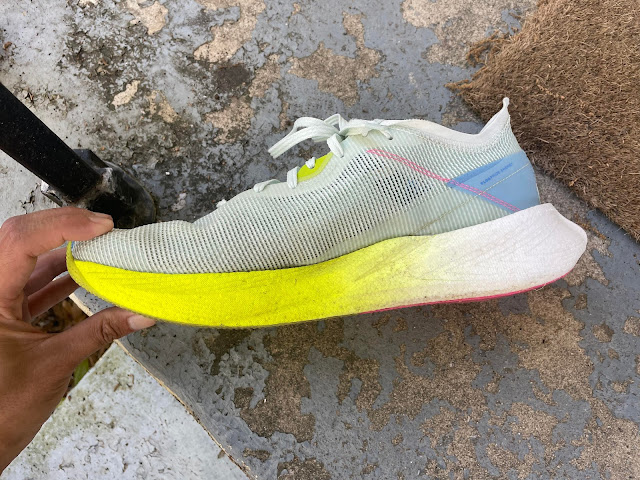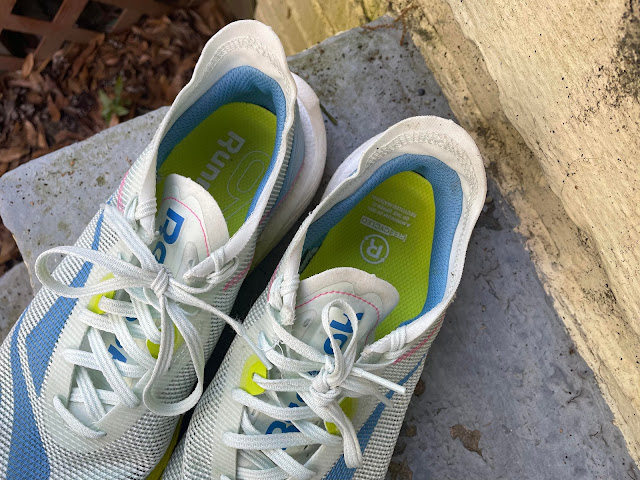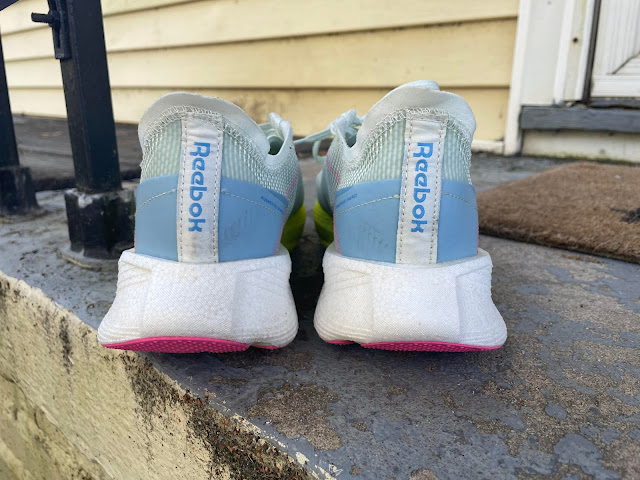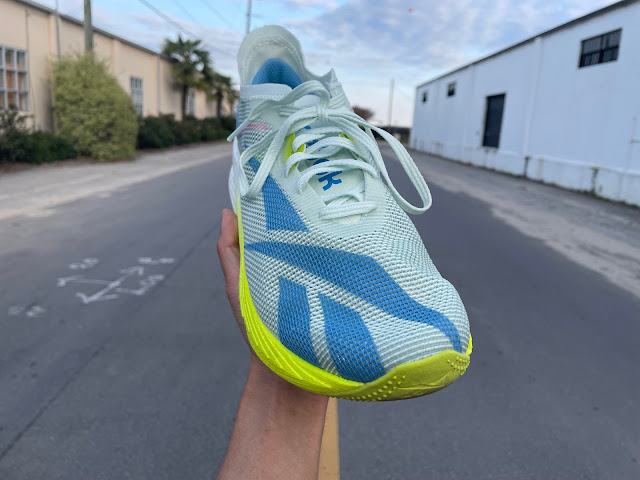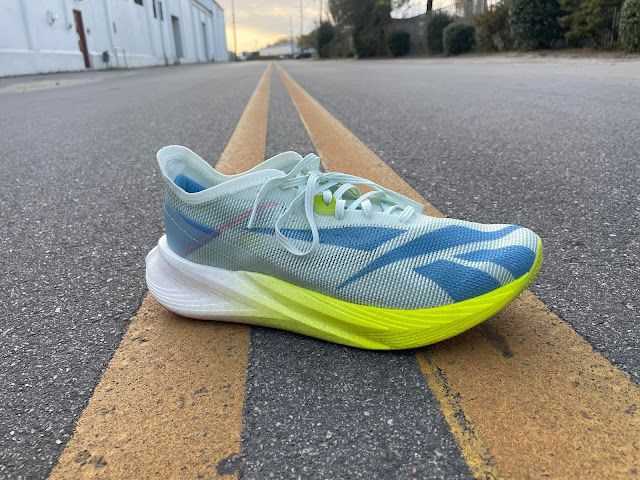Reebok Floatride Energy X Review: Entering the Plated Game
By Chief Editor Matt Klein and Social Media Manager Bach Pham
For the past few years, Reebok has shown glimpses of what it could be capable of in the running industry. The Floatride Energy series has become a fan favorite for both price point and performance. The Run Fast, especially it's early iterations, garnered a cult following for it's blend of lightness and performance. The Run Fast Pro put a sleek, ultralight sub-4 oz racing shoe in the market in the face of the growing super shoe trend. While these were successes in their own right, Reebok has been teetering on the edge of greatness due to a lack of a plated super shoe.
The Floatride Energy X presents their first big step towards that next level, offering a performance trainer with a carbon plated forefoot alongside the highest stack of Floatride Energy foam yet. Is this review, we explore the purpose of the Energy X and dive into whether or not this new entry is enough to lift Reebok into the competitive marathon racing game.
Reebok Floatride Energy XPrice: $170 at Reebok
Weight: 9.1 oz, 258 g (men's size 9/women's size 10.5) UNISEX SIZING
Stack Height: Not Provided
Drop: 6 mm
Classification: Forefoot Plated Marathon Racer / Performance Trainer
RUNNING SHOE SUMMARY
Matt: The Reebok Floatride Energy X is a soft, max cushioned, forefoot plated performance shoe touted as the "people's marathon racer." Featuring a huge slap of Floatride Energy foam underfoot, the midsole is soft throughout the length of the sole. The ride is moderately bouncy with some degree of ridigity in the forefoot, making for a performance trainer that works well for longer efforts like long runs and tempo runs. The additional weight and cushioning create a sturdy shoe that will work for those looking for a marathon shoe to get them through their longer races and workouts without being as aggressive as some of the other options out there.
Bach: The easy thing to say here is that we have a raised Floatride Energy embedded with a carbon plated forefoot. The Energy X, however, really only shares DNA with its trainer sibling in midsole. The shoe features a very high stack of Floatride Energy foam that emphasizes how comfortable and fun it is underfoot. A plated forefoot helps balance out the foam just enough to make the shoe a fun performance trainer built for long runs and for many a solid marathon shoe - not for those looking to fasten hard-hitting PRs, but for the typical marathoner looking for a comfortable shoe that can carry you 26.2 miles with plenty of protection underfoot.
FIT
Matt: The Reebok Floatride Energy X fits me true to size in my normal men's US size 10 (this shoe is only available in whole sizes). I have exactly a thumb's width between my 1st toe and the end of the shoe. That amount of room almost feels long at first but is great for any additional swelling over long miles. However, it fits more true to size for me due to a snug, shallow, and more tapered forefoot. The upper is made up of "Flexweave", a light and see-through mesh with an additional internal bootie for security. The tongue is attached to the internal mesh, making it gusseted and secure.
The fit is snug in the forefoot with a more normal fit in the midfoot and heel. The heel almost felt loose, but I never had to lace lock the shoe secondary to the additional hold in the forefoot from the internal bootie. Those with narrow feet will need to lock down the heel. A somewhat rigid heel counter sits in the rearfoot, with more stiffness at the rearmost portion of the counter and more flexibility on the side. I did not experience any additional pressure on my calcaneus thanks to moderately thick internal padding between the counter and my heel. I would highly encourage the use of socks with this shoe due to the internal mesh being fairly scratchy.
Bach: The Floatride Energy X comes in whole sizes only. I received a size 10 for review, a half size up from my typical 9.5. I would say the shoe is mostly true to size, but fits slightly loose in the heel. I had to really make sure I lace-locked the shoe to feel dialed in, along with wearing thicker socks. I would still say sizing up is the best bet due to the toebox being somewhat on the shallow side. If you are typically in-between sizes, I would say if you can fit between a 9 and 9.5 for instance, to go ahead and go with a 9, and if you are a true 9.5 onward, to size up to a 10 to have enough room for foot swelling during long efforts.
The upper of the Floatride Energy X is similar to the Run Fast 3: a one-piece upper with minimal padding around the heel and a rigid heel collar. Once I carefully lace locked the shoe and let it break in after a slightly longer initial run, the shoe felt dialed in just enough to be comfortable. I would really love to get half sizes to get the best fit possible, but the upper does do its job. It breathes fine and I ultimately did not have issues on my long efforts in the shoe. There is a low rigid heel counter with a flexible heel collar that's thin and very lightly padded internally on the heel.
PERFORMANCE
Matt: The Reebok Floatride Energy X works best as a performance trainer for uptempo and longer efforts. The large amount of full-length Floatride Energy foam underfoot provides a soft ride in the rearfoot and midfoot. Landing at the rearfoot provides a large amount of cushioning that feels more comfortable than fast. This transitions into a slightly rigid forefoot, which facilitates a more efficient toe-off. The soft landings and slightly faster forefoot transition make for a shoe that excels at moderate pace runs, long runs, tempos, and any effort where you are trying to hit a manageable pace for extended periods.
Particularly during longer and steady-state efforts, the ride is comfortable as it helps you roll along. There is a significant, but centered heel bevel in the rearfoot. Despite this, there is a larger amount of lateral flare, which causes an abrupt inward transition for those who land laterally and pronate. This rolls into the previously mentioned carbon-plated forefoot, which provides a stiff but consistent toe-off. The softer ride and forefoot plate work well for steady runs but responds too slowly for anything faster than tempo efforts. Despite being listed as a 6mm drop shoe, the static height feels a bit higher. However, during harder efforts when landing on the heel, the foam compresses a great deal. This makes for what feels like a lower drop, however, this may only be experienced by hard-hitting heel strikers like myself.
Despite my hard landings, the outsole has remained intact after 35 miles. I have only caused a small amount of abrasion in my normal spot (posterior lateral heel). The midsole feels has remained consistent throughout these miles and required no time to break in (although my body had to figure out how to work with the lateral flare). For those reasons, I expect the Reebok Floatride Energy X to last as long or longer than a trainer, which based on the industry standard is at or above 300-500 miles.
Bach: The Floatride Energy X is best suited as a performance trainer specifically for long steady efforts. The high stack of Floatride Energy foam is soft and comfortable underfoot, floating on the edge of stable thanks to the forefoot plate. The slight bit of rigidity in the forefoot in tandem with the foam helps facilitate a really nice, steady ride. I was able to lock in a variety of paces and just sit on the pace for mile after mile. Anyone who feels the regular Floatride Energy shoe bottoms out in long efforts will find this much more forgiving. I did not love the shoe for recovery efforts as the shoe really likes to get into a slightly more uptempo pace and stay in rhythm. I also did not love pushing the shoe to the edge for really fast efforts as it weighs a bit on the heavier end. This is a purposeful shoe best for long, steady efforts.
The Energy X, despite being 6 mm, feels like it runs a touch taller. This is most noticeable going downhill as you feel like you are really on your toes going downward which leads to some added instability. The shoe propels uphill well though with the springy forefoot. The outsole is full-length and fairly thin. It does a fairly decent job of gripping the road and giving a little bit of traction. I had two very wet road days in the shoe and was able to comfortably get through the run without any issues. I would not say the grip was stellar or use this for offroading in any way due to the high stack and relatively mild traction overall.
STABILITY
Matt: The Reebok Floatride Energy X is a neutral shoe. A strong lateral heel flare makes this shoe best for those with stiff ankles or those who need lateral stability in the rearfoot. However, this shoe is not appropriate for anyone with medial stability needs. The Floatride Energy foam is soft underfoot, making for a bouncy and mildly unstable ride. There are mild sidewalls in the midfoot that are not really noticeable, particularly while being pitching inward from the lateral heel flare. The forefoot is slightly stable due to the plate and the wider last. Those who land farther forward will find a stable neutral ride, while those in the rearfoot and midfoot will find a shoe that will work best for those with neutral mechanics or want mild guidance against lateral motion.
Bach: There's no doubt that the Floatride Energy X is a neutral shoe due to the relative softness of the foam underfoot on the run. That being said, a couple of things make it more stable to me than some rival shoes like the Metaspeed Sky which I personally have challenges with. There is a wide last throughout the shoe which gives a nice landing platform, making for a fairly stable forefoot and helping provide some support to the rearfoot. However, while the forefoot plate isn't that noticeable ultimately, it is noticeable that the rearfoot does not have a plate due to its softer, more flexible landing where the primary instability of the shoe is. A full contact outsole does help provide a smoother landing and a crash pad along with bevel does play a small role in helping propel the runner forward.
Finally, though soft, Floatride Energy X isn't exactly mushy like Fuelcell from New Balance or ZoomX from Nike, providing a touch more firmness that helps make it feel a bit more stable during long runs than its peers. Additionally, being only a forefoot plate, the shoe worked well for me as a flat footed runner who often does have some issues with certain shoes due to the stiffness against my arch from full length carbon.
At the end of the day though, this is a very neutral shoe in the heel that feels just stable enough in the mid to forefoot for long efforts.
THOUGHTS AS A DPT / FOOTWEAR SCIENCE
What is Lateral Midsole Flare and Who Does it Benefit?
By Chief Editor Matt Klein
Lateral midsole flare is an extension of the sole beyond the outer side of the foot. Like medial flare, this can provide resistance to motion in that direction. The major difference is during normal running and walking foot motion, most people will land more laterally and roll inward (both for heel and forefoot strikers). In this case, the lateral flare may cause an early initial contact or landing. This requires the foot to travel a greater relative distance to hit the ground, which generally means greater speed during the transition to being level. This additional speed and angle means a greater pitch inward, greater rate of eversion/pronation and more eccentric control needed from the muscles that invert the foot (as the foot is going into eversion). This motion control primarily comes from the posterior tibialis and anterior tibialis, with assistance from many others including the calves, flexor digitorum longus and flexor hallucis longus. Those who would like to run in the Reebok Floatride Energy X should ensure they have good strength and eccentric capabilities of the invertors due to the lateral sole flare primarily in the heel and into the midfoot.
There are some people that may benefit from lateral flare. As this produces resistance to lateral motion and facilitates medial motion, those who have lateral instabilities may benefit from this design. Those with a history of ankle sprains (lateral specific), those who tend to supinate or invert their foot too much throughout the first half of their foot transition will find this design will keep them more lined up. The last uptempo shoe that had this that I discussed was the New Balance Fuelcell RC Elite 1. That shoe features this design in the forefoot and did quite well for those who needed medial guidance there. This same concept applies to the rearfoot of the Reebok Floatride Energy X. Although the population that truly needs this is small, it is a great option for those looking for it.
RECOMMENDATIONS
Matt: The Floatride Energy X has been an interesting shoe to test. Billed as a marathon racer, it feels more like a soft performance training shoe that can handle uptempo/tempo work. If this is truly to be a racing shoe, Reebok needs to drop the weight to at least 8 ounces (or less). The weight is certainly a factor that contributes to the lack of versatility with faster paces, although it does feel protective over longer miles. This is more of a less aggressive "people's marathon racer" than elite marathon racer. However, there are several tweaks that could be made to make this happen, including using their Floatride PEBA foam and/or using a full-length plate to better stabilize the soft midsole.
The other major suggestion I have is to reduce the lateral flare or consider a posterior lateral bevel. Centered bevels work fine when the flare is equal, but in the case of the Floatride Energy X, my heel gets pitched inward hitting that lateral flare. If the goal is to create a unique shoe for those with lateral instabilities discussed above, then keep it. However, if this is meant for the majority of the population, this needs to be tapered down.
Bach: For the shoe itself, half sizes are absolutely needed to help dial in
the fit for runners which would tremendously help ensure the best
lockdown possible for long miles. Playing the full size game can be
tremendously difficult for runners and possibly deter shoppers from
trying what is otherwise a very fun shoe. I would also be interested in
seeing the Speed Shift Upper from the latest Floatride Energy
transferred over to help dial the upper in further. It made a huge
difference from the Floatride Energy 3 to 4, and I think that connection
would be appreciated here as well.
For my needs personally, the Floatride Energy X actually works quite well for a marathon distance shoe, aka a piece of footwear that would be comfortable for logging long miles to finish a marathon. For many people, this will be enough shoe to get that done comfortably at a steady pace. For veteran runners looking for a pure marathon racer - like the Vaporfly or Adios Pro for instance - this is not going to get the job done due to its weight.
I think there is a space for the Energy X as is. Rather than revamping the Energy X to be the pure marathon racer, I'd perfer Reebok to invest in another shoe altogether that drops the weight significantly, likely tapping into their Run Fast series and PEBA foam utilized there. That would give a veteran option alongside an everyday runner's choice with the Energy X.
WHO THIS SHOE IS FOR
Matt: The Reebok Floatride Energy X is a performance trainer for those who have neutral or laterally deviating foot mechanics wanting a forefoot carbon plate, a soft heel and a shoe that works well for uptempo and longer efforts. The high stack height makes for soft heel landings, while the slightly more rigid forefoot creates a steady toe-off. The upper is secure in the forefoot, providing a slightly snug and shallow fit that offsets a slightly loose heel. The Floatride Energy X provides enough cushioning to double as a lighter training shoe but has enough resilience to handle longer uptempo efforts. This makes it a solid choice for anyone looking for a marathon or uptempo workout shoe that is far more forgiving, less aggressive, and more affordable ($170) than many of today's plated racing options.
Bach: The question I would ask prior to purchasing the Reebok Floatride Energy X is "what kind of long run/marathon goals do I have?" If you are looking for a steady, slightly uptempo trainer for long runs and possibly to run a marathon in - not for time, but for completion - the Floatride Energy X is a really nice option that provides cushion, a bit of forefoot stability, and decent price point. I felt this shoe paired really nicely with the Floatride Energy 4 and both do a great job of highlighting what the foam can do. For anyone looking to dig deep for a PR, you will still want to look at the major super shoe players in the market today, but for runners looking at shoes like the Bondi X or even traditional trainers like the Clifton for a comfortable marathon shoe, this should definitely be worth considering in your short list.
FURTHER THOUGHTS
"The Reebok Floatride Energy X is a performance trainer that utilizes the famous Floatride Energy foam and adds a carbon fiber plate through the forefoot. The shoe lowers the drop ratio to 6mm and creates a more rockered geometry to the shoe than previous Floatride Energy line. The shoe has a nice balance to it with transitions and a relatively responsive and lively forefoot. Weighing at 9.1 ounces this is an awesome long run and performance trainer for me. I wouldn't quite reach for it on race day, but I ink a lot of people may still like this shoe for that marathon racing distance or for uptempo training."
- Senior Contributor David Salas
GRADING
Matt
Fit: B (slightly snug and shallow forefoot with normal midfoot width and loose heel. Internal bootie helps with security, but need to tie laces down. Skratchy internal mesh)
Performance: B+ (Softer rockered slightly bouncy ride with stiffer toe-off. Best for long runs, uptempo and tempo efforts. Too heavy and soft for faster intervals/speed and not stable enough for recovery runs)
Stability: B- (Wide last is offset by extremely soft midsole with lateral heel flare that induces early initial contact. Best for those who need lateral resistance)
DPT/Footwear Science: B- (Soft unstable ride with lateral heel flare induces early initial contact and unstable rearfoot. However, will work for those with neutral mechanics or those with lateral instability who need to pronate)
Personal: B- (The lateral flare challenges my ankles more than I would like. Great cushioned shoe for tempo runs, but there are far lighter options out there.)
Overall: B-/B (A performance trainer and "people's marathon shoe" for those with neutral mechanics wanting a softer ride and a forefoot carbon plate. May have versatility as a daily training and marathon shoe for some.)
Bach
Fit: B-/B (The lack of half sizing makes fit difficult. The heel itself and lacing doesn't quite nail the lockdown)
Performance: B+ (For its purpose as a performance long run trainer, it is a very solid, fun shoe. It is limited in utility which makes it miss out on an A, but if you have intention with this shoe it is great fun)
Stability: B+ (Though a soft midsole, there are components including width and full contact outsole which made the shoe more stable for me than many other super shoes and plated trainers I have tried for long efforts)
DPT/Footwear Science: B (Reebok did a nice job of highlighting the Floatride Energy Foam here, but sizing challenges and weight hold it back)
Personal: A- (Despite some sizing challenges, if I'm just dialing in on its purpose as a long run shoe I had a terrific time in the Floatride Energy X and would consider it for my personal marathon)
Overall: B+ (Though narrow in purpose, it does its job well and offers new marathoners a really nice option for the distance along with a great long run shoe)
SHOP | SUPPORT DORReebok Floatride Energy XPrice: $170 at Reebok
Using the following links to purchase helps support Doctors of Running. Thanks so much!
Check out Gear We Love
Feetures Socks: Massively grippy socks that will make you feel more one with the shoe
Ultraspire Fitted Race Belt: The best way to carry your phone and goods on the run. No bounce and various sizes for waist
Skratch Recovery, Coffee Flavor: Mental and physical boost post run. Coffee flavor is excellent and goes great straight into a fresh brewed cup
Trigger Point Foam Roller: Help get those knots out post-run and feel better for tomorrow
Theragun Massager: This small version is great on the go for working tired legs
Ciele Hat: Our team's favorite running hat of choice!
FURTHER READING
Science of Nutrition and Training for Women | DOR Podcast #82
Nike ZoomX Streakfly - The latest 5k/10k oriented racing flat that everyone has been waiting for
Reebok Floatride Energy 4 - A new sustainable upper highlights the update to the beloved trainer
Mizuno Wave Inspire 18 - Full length Enerzy marks the major change for the latest stability update
New Balance Fresh Foam X 880v12 - A well-fitting workhorse for your daily training needs
New Balance Fresh Foam X 1080v12 - The classic premium shoe from NB returns with a new upper
Find all Shoe Reviews at Doctors of Running here.
Thanks for reading!
FOLLOW DOCTORS OF RUNNING ON SOCIAL MEDIA
Facebook: Doctors of Running
Youtube Channel: Doctors of Running
Instagram: @doctorsofrunning
LinkedIn: Doctors of Running
Strava: Doctors of Running
Podcast: Virtual Roundtable
Pinterest: Doctors of Running
Contact us at doctorsofrunning@gmail.com
NEXT: New Balance Fresh Foam X 880v12

